Updated: February, 2022.
Want a comfortable rug pad that doesn’t slip all over the place?
Or maybe you just want something to protect your expensive rug or new floors.
Being around floors for the last 10 years, I’ve seen what types of rug pads damage floors, what features annoy homeowners, and the rug pads people love for years.
Now, the goal of this article is to help you figure out the best rug pad for your home (the exact pad specs you need varies based on a few of your home features… more on that later).
How to choose rug padding
I’ll walk you through buying a rug pad like a good salesman would. But since I don’t work for a rug manufacturer or don’t get paid to push a specific product, you don’t have to worry about a sales pitch.
Here’s what we’ll cover:
- Benefits of rug padding: It’s important to decide what’s important to you because that will lead you to the type of rug pad you need
- What size rug pad you need: This will be straightforward based on your rug size.
- Best type of rug pad: What material is best for your home, and which materials you should avoid.
- Rug-floor compatibility: Some floor materials are notorious for staining or degrading with certain pad materials.
- Rug pad thickness: Thickness starts at about 1/16″ and goes up to 8 times thicker. That can have big impact on how it performs, feels, and costs.
- My final recommendations: There’s no one rug pad for everybody, but here’s my best shot at the best rug pad for most people.
I’d recommend going through this guide from top to bottom, but you’re welcome to skip to any of the sections listed above by clicking the links.
P.S. This is my most detailed guide on rug padding, but if you just want answers to the best rug pad for hardwood or laminate flooring, you can click that link.
Benefits of rug padding
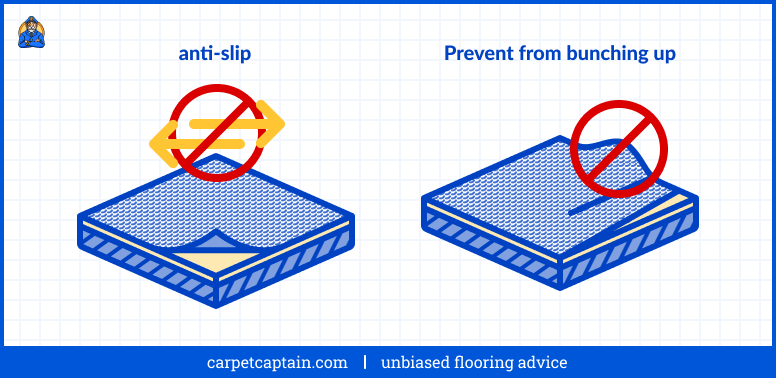
Rug pads are not just an upsell for the rug sellers. They bring several benefits to both your floor and your area rug.
The most important benefit is that the rug pad will keep your rug from slipping and getting bunched up. Bunched up or sliding rugs are a safety issue and potential tripping hazard for everyone, but especially kids, pets, and people with limited mobility. With the right rug pad, the rug will stay flat even on a smooth surface.
Did I say reducing slipping was the biggest benefit? On second thought, maybe it’s the fact that it protects your floor and rug. This is especially true if you have an expensive rug. The padding will give a cushion, just like carpet pad does to carpet, that keeps the rug from wearing out prematurely. But it also protects the floor. Some rug backings are abrasive to the floor beneath it. A good rug pad should prevent this.
And there’s also the benefit of insulation. This is a smaller benefit since the rug usually isn’t over your whole home, but it provides insulation against cold floors (so your feet stay warm) and sound.

Captain’s notice! When I link to a rug pad, I may get a small commission from Amazon based on what you buy. This does not affect what you pay or what I recommend. I only link to rug pads I would consider buying if I were in your shoes, and any commission helps pay the bills of the site.
What size rug pad do I need?
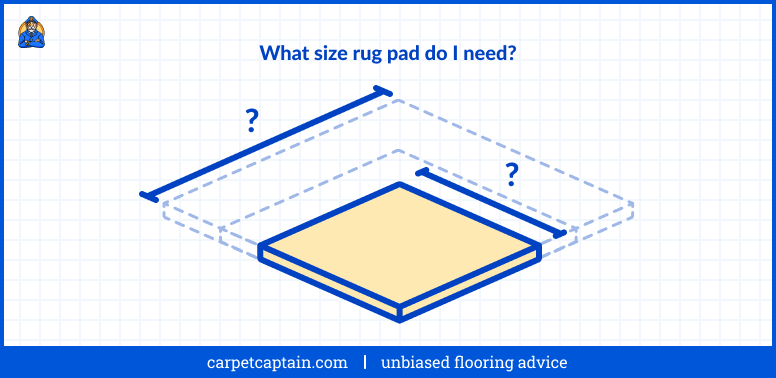
The first question you’ll come across is what size rug pad do you need.
As you can guess, it’s based on the size of your rug. Here are some common rug sizes, and the size of the rug pad you’ll need:
| Rug Size | Pad Size |
|---|---|
| 9×12 | 8’10″x11’10” |
| 8×11 | 7’10″x10’10” |
| 8×10 | 7’10″x9’10” |
| 5×8 | 4’10″x7’10” |
| 5×7 | 4’10″x6’10” |
Side note: Amazon can actually be a pretty good resource for area rug padding. In particular, there is a “rug store” on Amazon I like. They let you filter by size, and you can see what other owners think of them, and what rugs they’ve had success with click here to check them out. (note: I receive a small commission if you buy through Amazon, but this doesn’t affect the price you pay).
See the general trend?
The rug pad needed is 2″ shorter in the length and width. This makes a rug pad that is 1″ shorter on all 4 sides. Of course, you can always cut a rug pad that is bigger than your rug, and then trim it down, but definitely don’t go with shorter than the guidelines above!
Materials for rug pads and how they perform
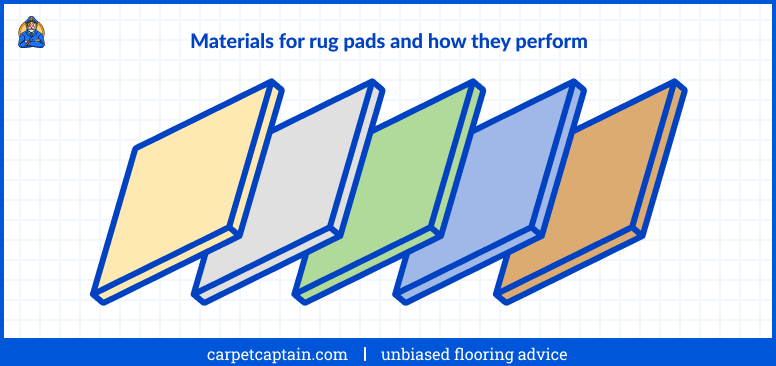
The material you choose for your rug pad makes a big difference in performance. You’ll
- PVC
- Felt
- Rubber
- Felt/Rubber combo
- Polyester and/or vinyl
Let’s talk about each briefly, so you can be familiar with their pros and cons:
PVC rug pads are generally less expensive than others, but can cause some problems with the floor. The plastic chemicals do not interact well with vinyl or hardwood floors, causing discoloration or voiding the floor’s warranty. They do make cheap non-slip surfaces. In most cases, I’d avoid PVC pads.
Felt pads are excellent for at extra cushion and support but do not do well at keeping the rug in one place. With larger, heavier rugs this will not be so much of a problem. Their thickness gives some added protection to your floor and more insulation under your feet. Felt pads are considered higher quality since they are great “shock absorbers” to give your rug protection. Here’s a 100% felt pad on Amazon that comes in multiple sizes.
Rubber pads are thin and sticky. They provide a very small amount of cushion and insulation, nothing compared to felt. However, rubber only pads are perfect for smaller rugs where they critical job is keeping it in place. They’re low profile so all you see is the rug; this is especially important for thin and small rugs. Here’s a rubber pad on Amazon in multiple sizes that has good reviews and is fairly inexpensive.
Felt and rubber are the best of both worlds, and my top choice for most homeowners. They give more grip like a rubber pad, but also the comfort and protection of a felt one. Combined pads place felt on the top, to prevent abrasions on the rug’s underside and rubber on the bottom to keep the rug from slipping. For most people with decent quality or better rugs, I think felt and rubber is the way to go. This is my favorite felt and rubber pad on Amazon at a good price. If that pad is too expensive, this is my second favorite felt + rubber pad, cheaper than the previous, but the rubber isn’t quite as high of quality in my opinion.
Polyester and vinyl are usually used for rug to carpet padding. This material does well for preventing the rug from bunching on the carpet but also not damaging the carpet beneath.

Captain’s warning! If you’re getting a rug for a carpeted floor, it’s important to look for a pad that is specifically a “rug to carpet pad.” Other rug padding designed for hard flooring may not work as well as it should on carpet, but worse, there’s a good chance it will cause your carpet to blossom or fray.
Materials for rug to carpet pads.I’ve received a few questions on specifics of what type of padding is needed for carpet. Usually, the same type of materials are used that are used for hard floors: felt and rubber, but how they are composed can be different. You don’t want the rubber too abrasive on the carpet, and it also helps to have a stiffer felt because the carpet already has some softness and give. Here a carpet to rug pad I recommend.
Still not sure which rug material you want? Your rug size can help you decide…
The last section gave you an overview of each material. And hopefully, it let you narrow down what you want.
There is one more consideration:
The size of your rug can help determine what material you should choose. Different sized rugs have different problems that the rug pad can fix. And depending on the problem to be fixed, different materials will be best:
Small rugs or runners
The smaller the rug, the harder it will be to keep it in one place without some sort of weight or padding. You will also want to keep the pad as thin and lightweight as possible since thicker pads would bring too much bulk underneath a small rug.
For these, a rubber pad is best, but it should allow air to flow freely or it can trap stale odors. The pad should be able to grip both the rug and the floor without sticking to your floor’s finish. That way, the rug will be kept from bunching together or sliding when you walk on it.
Here is my favorite pad to support smaller rugs.
Medium rugs
Medium rugs, loosely defined as those 4-5 feet wide and up to 9 feet long, don’t have quite the “banana peel” effect of smaller rugs where they slide under your feet. However, they still can have problems bunching up.
Unless your rug is under furniture, you’ll want rubber in your pad to grip it.A blended material will do the job best, with the felt side able to grip the rug and the rubber side keeping it together. Usually, a medium rug pad will be between 1/8 and 1/4 of an inch thick.
Here is my favorite pad to support medium rugs (note: this is a fairly thin pad, which I prefer for most medium rugs, but if you want thicker check out my recommendation for large rugs below)
Large rugs
Large area rugs frequently take up most of a room and often have furniture such as couches and chairs placed on top of them. Those will help to hold it in one place, but even then the pads are necessary to keep the rug and the floor in their best condition.
A felt pad is ideal for large rugs that are heavy or bulky enough not to move on their own. They add extra comfort and provide a layer between the floor and the rug so neither of the more valuable items becomes damaged by constantly grating against each other.
If your large rug is in a high traffic area, is thinner, or tends to slide or bunch up to one side, then you would be better off using a combined felt and rubber pad to keep it in one place.
Here is my favorite pad to support large rugs.
Floor compatibility
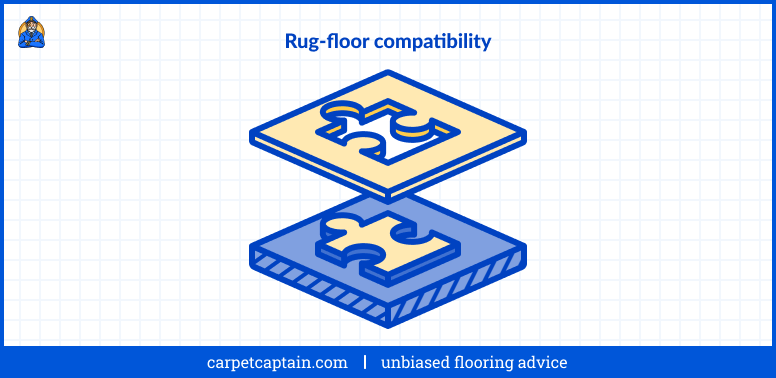
We’ve covered materials of rug pads and choosing your rug pad by size, but there is one more thing that may be the most important:
Compatibility with your floor.
One rug pad may work great on carpet, but it might slip on hardwood. Or another rug pad might leave your hardwood looking flawless, but stain luxury vinyl flooring that is under it.
The challenge here is there is no one size fits all answer. However, there are a few things you can consider.
- If you’re putting the rug pad on top of vinyl flooring, read the manufacturer’s guide on the vinyl floor. Many prohibit the use of certain pad materials (PVC is a common one)
- If you’re putting the rug pad on carpet, there are carpet specific pads that may be preferred. Rugger based pads could wear on the carpet with time.
- Outside of these two exceptions, most pads are universal with floors like tile and hardwood. However, considering the amount you invested into your floor, I would still read what the manufacturer recommends to be safe.
Rug pad thickness
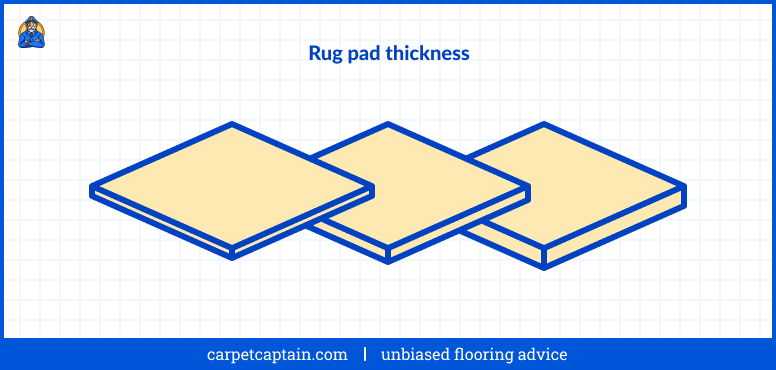
Another decision you’re going to make is how thick of a rug pad you want.
Some people like to go with the “squish test:” pinch the pad between your fingers and figure out more comfortable.
But there’s more to it than that. The thickness can affect the performance, functionality, and safety.
You’ll find rugs pads anywhere from 1/16″ to ½”. That’s an 8x difference in thickness! Usually, people tend toward thicker pad, but there are times where thick may NOT be better:
- with a thin or small rug (you don’t want your pad getting more attention than your rug)
- the rug has to be cleared by a doorway
- with too thick of a rug (who wants to step over both a thick rug and pad?)
Shameless advertisement that I stand by: Want to shop for rug padding? Click here to check out a rug pad store on Amazon that has great quality and lets you choose by about any size.
Thicker pads are going to cost a little more, and give your rugs more protection. If you have a nice, thick oriental rug, you’ll want to protect it with a thick pad. However, if you have a thinner less expensive rug, you may just want your pad to keep it from slipping. You only need a thin pad to do that.

Captain’s warning! Don’t forget about your surroundings! While thicker pads are often preferred, be sure that you don’t have a door that opens over the rug, or that the rug is in an area that potentially could be a tripping hazard. These cases a little thinner may be better.
Captain’s parting words!
I hope this helped you pick out the perfect rug pad for you. But if you still want help choosing the best, here are my favorite rug pads for most situations:
- Most people will want a felt and rubber mix because it gives you all the benefits: cushion, non-slip, insulation, and protection. My favorite felt-rubber pad is this one. These pads can get a little pricey, and if you want more of a budget option, this is second best.
- If you have a really big rug or a rug that’s under furniture, you may not need the rubber. You can get by with just a felt pad like this one.
- If you have a small rug, the goal is to keep it from slipping beneath your feet like a banana peel. This rug pad should do the trick.
The rugs I chose above are a fairly standard thickness (in the middle). If you want more cushion, go thicker. If you’re afraid of tripping or it getting in the way, go thinner.
Hope that helps. Let me know if you have any questions in the comments below.
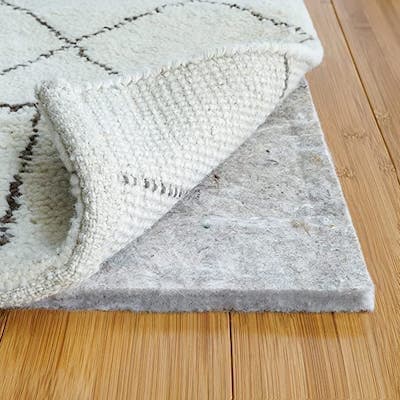 |
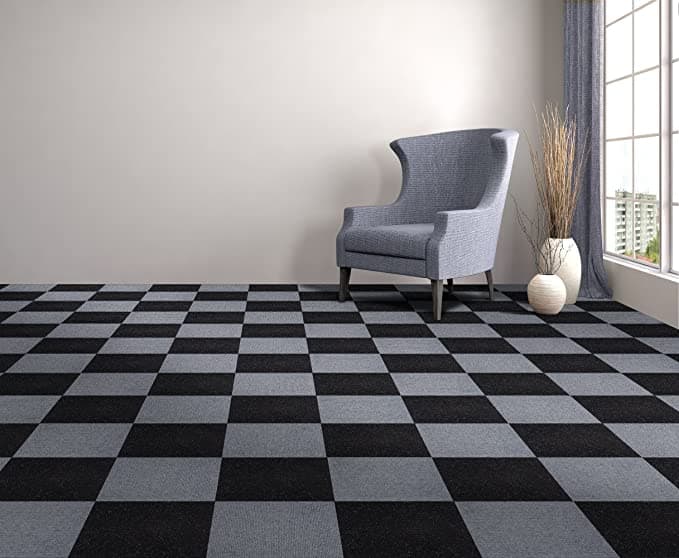 |
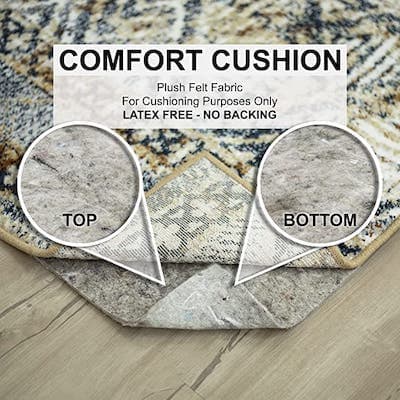 |
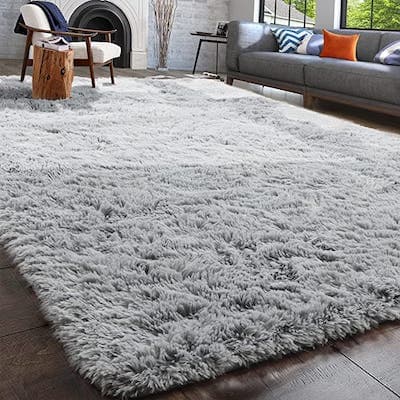 |
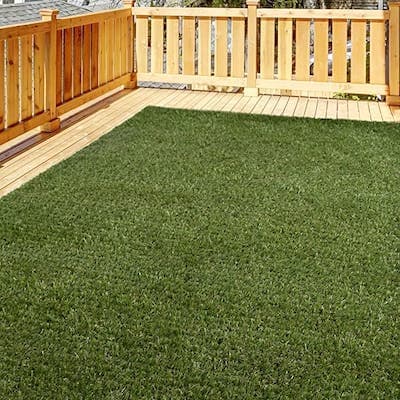 |
|---|---|---|---|---|
| RUGPADUSA Cushioning Rug Pad | Peel & Stick Carpet Tiles (12 sf) | Mohawk Home Rug Pad | PAGISOFE Fluffy Area Rug | Faux Thick Realistic Grass Mats & Rugs |
| 4.5 18500+ ratings |
4.7 1100+ ratings |
4.5 12500+ ratings |
4.3 2000+ ratings |
4.5 1800+ ratings |
| $25 - $100 | $10 - $25 | $50 - $125 | $25 - $75 | $50 - $150 |


Sorry just saw the 1” boarder guideline. Still curious about my thickness question. Thank you!
Good article. I’ve noticed that when I order the same size rug pad as the rug, it doesn’t fit well, so I wind up buying bigger and cutting to fit. Is that common? Also what size do you recommend for plush 2” rug or thick 1-2”? A chart would be great – pile thickness, mat thickness, feel. If you cut to fit, about how much border should you leave to help with occasional rug slips (e.g. 4×6 oval hall rug) so mat doesn’t peek out? 1”? 3/4? Thanks for the great info!
What outdoor rug pad do you recommend for an outdoor 9.6’ x 12’ rug on a cement patio?
Hi,
I have an 6’x9′, 3/8″ thick wool area rug and am looking for a pad. It’ll be on Saltillo tile, so a hard but uneven surface. It’s also have a coffee table on it. It sounds like you generally recommend a 7/16″ felt and rubber pad for large area rugs. What thickness would you recommend?
I’ve never had a rug like this before and am concerned that 13/16″ total thickness might be too thick, but perhaps this thickness would be pretty standard?
Thanks!
The carpet to rug pad you recommend is no longer available. Do you have another suggestion? Look for something to accommodate runners on top of my wall-to-wall. Thanks.
I recommend different products in this article, could you be more specific? Please share the link to the unavailable product.
Greetings:
My rug is 5’3”x7’10. Is a 5×8 pad close enough? I can take off 2” from short side. But is 5’ to short for a 5’3” rug? It’s an inch shorter than recommended. Thanks.
Hi,
I would say it’s close enough, just trim it down so that the rug pad fits better, as per the guide.
What is the best tool to cut the felt/rubber pad combo?
Hi,
I recommend using a sharp utility knife – change blades as necessary because sharpness is important! Use a long straight edge, such as a 2 x 4, to compress and stabilize the padding by standing on it, so that it’s easier to cut.
Good luck!
I have a 8 x 10 area rug going over vinyl flooring. I don’t want to stain the flooring and dont know who the manufacturer it is to check with their comments on this . I want cushion and maybe in slipping. What’s the best choice ?
Hi,
Manufacturers usually don’t recommend using rugs with rubber backing. I recommend checking out Anchor Grip, Eco Plush, and Cloud Comfort rug pads.
Hi Carpet Captain I’m a little confused about the size of the pad. I’m looking at. 9×12 area right. You chart recommends 8.10×11.10. Pads are 8×10 or 9×11. You also state they should be 2” shorter in both length and width. They’re expensive so I want to get the right size and not have to trim it.
Thank you
When I look at the photos of felt pad on Amazon Catherine, they show a person cutting the pad with scissors. I’m assuming that’s what I’ll have to do to make it a little smaller than my rug. Be sure not to trim it until you measure the exact size of your rug, as they’re often not exactly the size they say when you order them. There can be a few inches difference in any direction!
I lay out the pad and rug for two sides (1 corner) to fit, then use sewing scissors to cut the other 2 sides. I’ve had better luck going 1 size bigger to get a good fit, given I’m going to cut anyway. I’ve used a number of different brands, but I like Wayfair’s own brand the best, available in different thicknesses.
Kelly is right. You’ll have to trim the padding to get it right. Thanks for reading!
Hi, I am primarily interested in purchasing a rug pad to reduce ambient sound coming from our second floor music room to my downstairs neighbor. Is the felt and rubber pad best for that or is there another pad you recommend? If the felt and rubber paid is the best is there a signficant difference in sound reduction between the RugPad USA and Mohawk ones? Thank you.
I need your expertise in selecting the appropriate pad for a recently arrived carpet.
it’s a patchwork kilim 3′ x15′ runner to be laid on a high-gloss poly parquet wood floor.
I want the rug to stay in place, and I’d like to have as much cushion as possible without exposing the runner to potential damage.
How thick should the pad be, and of what material?
THANKS!
I like this one for you. Sometimes I like pure rubber, but that wouldn’t give you much cushion. The size comes a little short on the long end. You could buy a 3’x7′ and a 3’8′ and combine with glue and or staples.
I bought a large area rug and a felt pad. One side of the pad is rough and the other is soft. Which side should be up?
The rough side is recommended to be up (against the rug), but many people do the opposite. Rough side down risks scratching the hardwood.
What is the best way to join two pads under a large rug?
You might try a rug tape like this one. It’s double-sided, so you could put it floor to pad and pad to rug to hold the pads together but also keeps the rug and pad from slipping.
Hi, I’m looking to add a 9×12 rug to my living area over engineered hardwood. The flooring company says not to use rubber backing. Fortunately the rug will be anchored by furniture so trying to decide which rug pad to use. Thinking either the felt or memory foam option with no rubber backing. I’m also struggling with the thickness. I’d love it to be cushy with a baby but also don’t want it to cause a tripping hazard for clumsy family members and an old dog. The rug that will be on top is 1/2″ thick. Any suggestions? Thanks!
Can’t guarantee it, but I think if you want soft and it’s under furniture, you’ll be fine going with a thicker rug pad (close to 1/2″). It will matt down some with time–the foam probably more than the felt.
Hi!
I read your article & found it helpful. One question…. if we have to go with a larger size pad, can it be cut to a more customs size?
Thanks
Tricia
Yep, they can be cut and most aren’t too difficult to cut with a utility knife/box cutter.
Hi! I just bought a 6×9 wool rug that’s 3/4” thick. I’m wondering what thickness of a pad i should get. I was thinking a 1/4” felt pad (it’ll be under a couch and coffee table) would probably but wanted an expert to weigh in
Think you’re spot on. I’d go with felt, and 1/4″ would definitely work. Could consider thicker for more softness if you walk across it.
I have an 8×10 jute rug that I’m going to be putting on hardwood floors in my dining room. What rug pad would you suggest?
I’d go with this one. It’ll give good support and keep from slipping (assuming it won’t be under furniture holding it in place).
I am reading conflicting information about carpet pads atop cork floors. We purchased an 8 x 10 area rug and need a pad. What material(s) should we get? What do we avoid?
I haven’t heard of issues with cork flooring and discoloration like you will with vinyl, so I think you’d be good with a mix 100% natural rubber + felt (be careful because not all rubber backings are natural and can cause problems) like the pads listed on this page. I’d check your flooring manufacturer for anything they avoid against specifically–sometimes, the coatings they use on the cork can matter. If you aren’t as concerned about slipping (like if the pad is under furniture or not in a main walkway, 100% felt would be an even safer choice.
We’re using area rugs instead of wood or vinyl in a room in our basement, because of modest moisture problems. What type of pad do you recommend for over concrete. Thanks.
I’d check out memory foam like this one. Pure natural rubber would probably be the best (examples above) for moisture resistance, but it won’t give you much pad or insulation and most people want that in a basement pad. The memory foam is viscoelastic, which should also do a good job of moisture resistance.
Hi there, thanks for providing such concise information about rug pads. I am looking for a felt pad for under a Persian rug 6’6″x9’7″ under a dining room table, in a corner. Hardwood floors. Would you recommend 1/4″ or 3/8″? Concerned about trip hazard, as 2 sides are walking areas, as it’s a very small house.
Thanks!!
I’d probably go with the 1/4″ in your case. The table under the pad can cause it to lift up on the edges a little, so I think the reduced thickness will make less of a tripping risk. Plus, it’s a smaller home so not as much room to walk around.
hello! I bought this rug in 6 X 9 and can’t decide if I should buy a 1/4″ or 1/2″ rug pad? Please let me know what you think! https://www.jossandmain.com/rugs/pdx/wesham-oriental-denimnavy-area-rug-j000146904.html
If it’s in the middle of a walkway, I’d lean toward 1/4″ with it being a less expensive rug. 1/2″ would give you a little more protection
We need a pad for a 9×12 rug over hardwood. We don’t need grip as the large rug will be anchored by furniture. What type and thickness do I need?
I’d probably go 1/3″ to 7/16″ in a felt only pad. I like a little thicker under the furniture with a bigger rug like that.
Would the recommended rug pad- 1/4″ thick (RUGPADUSA) be suitable for a 6’x9′ rug with a .25pile? thank you!
The thickness is fine–it’ll be a little thin which is nice for a low profile but not quite as soft. You didn’t mention the material, but some of that depends on if the rug is under furniture–you can look under the “medium rugs” and “large rugs” sections for some tips.
Putting large oriental rugs on LVT flooring with radiant in floor heating. Appreciate your suggestions!
I’d first make sure your oriental rug is okay with radiant heat (if you haven’t already). They can be made of different materials, and since they aren’t cheap, I’d want to make sure it wouldn’t buckle or otherwise damage your rug. For the pad, I’d avoid rubber and consider a thinner pad.
I have an area rug over carpet under the dining table. The chairs and table have made the rug not lay flat and ripple, a safety hazard! How do I fix this problem?
A dense and not too thick pad would be good. But sometimes you need a little more assistance. Some people have luck using carpet tape (click here for one on Amazon) to tape the rug in place on the floor, especially if it’s on carpet.
You sure seem to know your stuff and I appreciate your sharing your knowledge with the rest of us. I am moving to an older home and just had the original hardwood floors (oak) redone. I love the look but I’m going to need some area rugs. I’m trying to find economic one and have seen ads for new washable “ruggables” or equivalent rug and pad systems. What are your thoughts on these? First and foremost I want to make sure the pad does not discolor or harm the newly refurbished hardwood. Thanks in advance for your insight.
Here is the address for some information on materials. https://ruggable.com/pages/materials
Unfortunately, I haven’t used or tested these so can’t give an opinion on your hardwood 🙁 I don’t see a big benefit in washing my car pad, and if the pad failed you and stained the hardwood that would be a big cost, I’d personally avoid it for now.
We’re giving our son and his family a 9 x 12 area rug made of indoor/outdoor fabric to use on a patio that is roofed, screened in and enclosed by storm windows in the winter. The floor is concrete that is painted. What would be the best kind of pad for this use?
I’d avoid anything with jute and go with a synethic fiber or pure rubber pad. Even though it may not be directly in the elements, it’d be prone to mold.
What pad would u recommend for a denim rug
I’d imagine denim slips fairly easily (assuming it on a hard floor), so I’d definitely have something with rubber mixed in. I’d personally also go a little thinner on the pad, but otherwise, the suggestions above still hold.
I have concrete floors and an older 6×9 Dual Surface pad (rubber nonslip on bottom/felt on top) and I just purchased a new 8×10 rug. Obviously a size discrepancy. Looking to save some money and not have to purchase a 2nd pad if I don’t have to. Will the 6×9 pad suffice with an 8×10 rug?
33% of the rug won’t have padding (80 square foot rug vs 54 square foot pad), so, unfortunately, not sure that would be a great way to go. You could still pull it off and it will give cushion under the rug centrally, but it won’t be great for support.
Hi—thank you for sharing your hard earned knowledge. If you ever have a tax or knitting question, send me a note. I have a 13 x 19 ft silk and wool oriental, not too expensive, but lovely. I’m trying to call me ombine it with a bad dog, periodic visits from toddlers, and a dark oak hardwood floor. In your area rug comments, I’ve not seen anything about a moisture barrier, but I think it would be a good idea. That, or use the kids’ college money to eventually replace the rug and train the dog. Comments?
P.S. I’ve thought about using Stainmaster Supreme Memory Foam, and making one, but worry that it might be too thick, like the dog’s skull. Help!
Lol… not quite the same, but I cover moisture barrier for carpet. Moisture barrier definitely works, but a lot of times doesn’t live up to the goal of the homeowner. Maybe I’m not understanding, but the problem with the rug is if the thick-skulled dog pees, it still saturates the rug (maybe even more so with the moisture barrier). The benefit might be it won’t leach onto the hardwood (and maybe a big benefit because the last thing you want is the oak ruined).
I am purchasing sisal rugs , 8×10, and would like advice about thickness. They will be under furniture and are stiff so i am not worried about them moving around. However I would like them to lay flat as close to the floor (hardwood) as possible to avoid tripping on the edges. Can you suggest a thickness?
I’d consider 1/8″ thickness. Should give a pretty low profile.
What would be the best type of padding to use on a 8′ x 10′ polypropylene Oriental style rug that has a 1/2″ thick pile and is on a vinyl plank flooring? The manufacturer recommends not using rubber on the floor. The location is in the mountains with high humidity and air conditioning is rarely used.
Many vinyl manufacturers recommend against rubber, but it’s great for grip. An alternative is PVC, but that’s typically worse for staining flooring, so I’d avoid it. Good news is your rug is fairly large, so it won’t slip out from you like a banana peel if you step on it even without rubber. I’d look into felt; you can see some good examples above under “Materials for rug pads and how they perform.”
I have laminate flooring throughout the first story of my home and several area rugs with thick felt pads for cushioning. Although those pads are supposed to prevent slipping, they do not. I have tried using a variety of “corner” non-slip grippers but they don’t really take care of the problem. At this point I’m thinking about getting the thin jute + rubber gripper pads, sized to fit each rug, to take care of that problem. Is this advisable or not? Thank you in advance for your feedback!
Does your felt have rubber? If not, there are a few options of felt mixed with rubber above. The jute and rubber could serve you well too and the “all-natural” aspect of jute is a bonus.
What kind and size of padding do you recommend for 9×13 shag rug?
I’d go just under the size of the rug so about 8’10″x12’10”. Check out the pad under medium size rugs in the article; it should be a good fit.
I have a large (11’x13′) area rug that I’m putting over a pergo floor in the living room. I was wondering if I could take two pieces of carpet padding (like https://www.homedepot.com/p/Contractor-6-7-16-in-Thick-6-lb-Density-Carpet-Pad-150553466-33/204414823) and use them. Or is that a completely terrible idea?
Not completely terrible. It is a little thick and not as dense for what would be ideal with rug pad. If it’s not a super valuable rug, and you don’t mind the height, it may work. The other problem is it may slide around on the Pergo.
Thanks for the great info. They say a rug pad should be 1-2″ shorter on all sides than the rug. I understand not wanting to see it, obviously, but if you make it smaller than the binded edge or fringe than aren’t you subjecting your hardwood floors to possible damage since 1-2″ of the rug backing isn’t protected? I’m a first time wood floor owner and want to protect them to the best of my ability. It just seems to me that you cover ALL of the backing, except for the binding and/or fringe to make sure and protect your floors. If you don’t won’t your floors get scratched over time where the pad is missing(those 1-2″)? Thanks for your help.
The pad still keeps the 1″ overlay from resting on the floor. The only issue is when people step directly on that area, but even then the pad offers some protection. If you wanted to be extra cautious, it wouldn’t ruin the appearance to go close to or to the edge of the rug.
Thank you!
I want to install a heated floor under plank porcelain. My concern is that a rug and pad placed on this type of heated floor may reduce the heat of cause a fire. How safe is it to place a rug and pad on the surface of a tile heated floor? I called the tile company and was told not to have a rubber backing on the rug. Need some accurate advice.
When it comes to things like fires, I’m going to defer to the manufacturer… sorry. I can say that many people put floors and things on top of heated floors–the biggest issue is usually not blocking the heat and making the heater inefficient. Every radiant heat system is a little different. I’d contact the company and ask what they specifically recommend for pad.
Hi carpet captain! We have a 9×12 flatweave dhurry area rug (ie a thin rug). It’s going in a toddler’s playroom, so we want the pad to be really squishy and comfortable so that we can sit and kneel on the floor easily with the baby and baby can tumble down without hurting himself. But, we also don’t want a thick pad to be a tripping hazard. We were thinking a memory foam pad, but we were nervous about it being a tripping hazard. Thoughts?
Tripping is worth considering, but I think you’d do okay. And I agree the baby falling and you guys kneeling the thicker pad would be appreciated. As long as there are no doors to clear, I’d consider going as high as 1/2″ with memory foam.
Our dinning room rug is a rectangular- 8 x 13′ wool braided area rug, 7/16″ thick. A rug pad that would prevent the yarn strands from separating, stretching and dents from forming in the rug is what we’ve been searching for. Do you have any suggestions to what type of pad we should purchase? Thank you.
You would probably do pretty well with this one. It’s a little bigger than you’d need, but you can just trim some off. It’s a dense felt that should help prevent denting and stretching, and I chose a bit on the thinner side (although if softness was important you might go up to 7/16″). Soft pads are particularly prone to this because of their give.
I have a 90 inch round rug. We want to buy a pad that is one inch smaller on all sides. Do we order an 89 or 88 inch diameter pad?
The 88″ pad would give you an inch on all sides
Hello , I just got a super thin approximately 8×10 area rug , it’s on a hard wood floor and desperately need cushion for it . It is a living room rug wirh some furniture on it so sliding isn’t an issue . Which padding and thickness do u recommend?
Thanks so much
You have a few options, but I’d probably go with 1/4″ felt or similar. Felt will give you good cushion, and in your case, you shouldn’t need the rubber.
Thank u so much
Thank you for sharing your knowledge! I have a 9×15 area rug in our living room, lower end of pile, and am considering a memory foam pad for our hardwood floor. We sit on our floor a lot, have a dog, and the LR is above a bedroom. It seems memory foam would be comfy and possibly help reduce noise. My concern is memory foam damaging the hardwood. Would love your thoughts, and recommendations, so I can support you. Oh, and what size pad do u recommend?
Memory foam should be fine. It shouldn’t damage the hardwood, but memory foam varies more than any other pad, so I would reach out to the manufacturer of the specific memory foam you’re looking at to make sure it’s compatible with hardwood.
We have selected a 9×12 hand-tufted wool rug to go under our grand piano. The room is large with high ceilings, wood floors, wood blinds, and mostly wood furniture, so we need to improve the acoustics and deaden some of the reflective sound under the instrument. Do you recommend an 1/8″ or 1/4″ pad. The pads are both made of combination felt and rubber.
I’d go with the quarter inch… it’ll give you more insulation and the rug is big enough to justify it.
What is the best type of pad for an 8′ x 8′ square rug going on ceramic tile?
The good thing about this rug size is you have some flexibility. If it’s under furniture, I’d consider a felt only pad. Any other case you’re definitely going to want rubber to keep it from slipping on the ceramic. I’d look at the medium size rug pad and maybe the large size rug pad above. The large size especially if you’re in a climate that gets colder because it has more insulation.
This information is VERY helpful! Thank you!!!
Is it unwise to use a thin reasonably dense pad under a large oriental rug? My rug is 10 x 18 ft, about 1/2 inch thick uncompressed. and anchored by furniture. The pad I am considering is 3/8 foam at a 5 lb. density. I don’t see this recommended as I see many felt pads, but I didn’t find it specifically excluded either.
The thin won’t matter and actually might help some with foam. Foam can vary a lot based on materials/construction, unlike felt. The main disadvantage is it can have more “give” making the rug more likely to bunch up and possibly wear the backing over time. You won’t have to worry about a large rug anchored by furniture bunching. If you’re walking on it frequently, I’d personally be a little concerned about the wear. If it’s not walked on frequently, don’t think it’d matter too much.
I’m happy to have discovered your website and like the idea of the thin jute/natural rubber pads if they don’t smell, mold, fall apart, last long and are feel reasonably cushioney. Can you verify for me this is all true please? I currently have a thin brown natural rubber pad purchased from a local store years ago that’s holding up well.
Related question: I recently tossed hundreds of dollars of waffle pads that crept around on me for 14 years so I was constantly trimming and adjusting them. Meanwhile the Waverly area rugs above the waffle pads our pouring out what looks like white sand (buckets full). At first we thought maybe the pads were contributing, but now I think it’s the glue backing on the rugs; yet most of the sand is coming UP through the rugs, with some down through the waffle pads. They weren’t expensive rugs, but not cheap either. Have you ever heard of this problem?
Merci much
I like jute/natural rubber, but one of jute’s biggest “flaws” is it can mold easier than synthetic materials if it gets wet. For the “sand” coming out of the rug, you’re on the right track: it’s usually the backing (which has glues) breaking down. It still may hold up for years, but the debris will probably be a constant problem until you replace the rug.
I have an expensive handwoven wool rug made in New Mexico. It is not very thick and it has stretched out in places so that it doesn’t lay completely flat. Can a permanent backing be applied to it?
You can replace the backing (not to be confused with padding) on some rugs. If I were going to do it on an expensive rug, I’d take it into a rug shop and have them work on it. You could DIY, but it might not be worth the risk.
I just purchased a 9′ x 12′ area rug for our engineered hardwood floor and am looking for a pad to go under the rug. The warranty information for the engineered hardwood floor specifies “Do not use area rug cushions constructed of rubber or PVC. Instead use urethane backed products.” What exactly is a urethane backed product? Does this mean I cannot use a 100% felt pad? Thank you for your expertise and time.
I’ve never seen 100% felt be a problem for a floor. I can’t say 100% for yours, and you could contact them to be sure, but I’d imagine they are fine with felt. Urethane is a foam-like cushion, but I don’t see it used too often for rug pads.
Hi,
I’m looking at rugs that are 1/4 inch thick. I think this is way to thin but I love the colors and design. Can I use a rug pad that’s an inch thick ? The rug size is 6×9. This is for my bedroom and it’s going over cork. I’m looking for comfort since I do floor exercises.
Thank You
An 1″ would be thicker than I’d recommend (pretty elevated from the floor), but I don’t think it should cause a problem with the rug. The only way it might is if it has a lot of “give” it could wear down the rug backing over time.
What is the best rug pad to get to cancel noise? The people below me always blast their music. I need a rug pad ASAP. Please help!!!
Felt is a pretty good sound blocker. You’ll want to go as thick as you can… probably about 1/2″
Greetings,
I am looking at purchasing an 8×10 shag style area rug for a room that has a tile floor. I am thinking of a pad for this carpet as we like to sit on the carpet so we would want some comfort but not sure what kind of padding we should get. I added a link to the carpet we are looking at.
The carpet we are looking at is https://www.overstock.com/Home-Garden/Safavieh-Cozy-Plush-Dark-Grey-Charcoal-Shag-Rug/20602811/product.html?TID=Cart:Link:ProductLink:CartItems
Product info:
Features:
Plush, luxurious shag style
Extra thick high pile height of 2 inches
Dark grey color with silver flecks
Sturdy polypropylene backing
Virtually non-shedding polypropylene fibers
Solid power-loomed construction ensures durability, and long-lasting beauty
Great for contemporary, modern, glam, minimalist and casual decor
Bring a designer look and feel to the living room, bedroom, kid’s room, dining room, or home office
Any assistance would be greatly appreciated.
Thank you!
Since it’s on tile, I’d go with a pad with rubber in it to prevent the rug pad from slipping. You also want comfort, so I’d check out one of the rubber-felt combination pads I have listed above.
What would be an appropriate thickness since it has a 2-inch pile? I don’t want it too thick that it looks out of place.
Also, Is 7×9 pad appropriate for an 8×10 rug? or should I go with 8×10 pad and cut it? A lot of pads do not come in 7’10″x9’10”??
You could really pull off either, but I’d go with the 8×10 and cut. The problem with the 7×9 is you’ll have 6″ on all 4 sides not under pad, which might look and feel a little sloppy.
Since your rug is already thick with that pile, I’d go thinner on the pad. Personally, I’d go with around 1/4″ but that’s not going to have quite the cushion of thicker (your thick rug would make up for it in my opinion)
Can I combine two rug pads for one large carpet? I am looking for a 10X14 pad and found out that it is cheaper to buy 2 5X7 pads.
Haven’t done this myself or known anyone who has but imagine it’d work. I think there’s a chance you can slightly feel the split between the two pads and attaching the pads together may not hold up (eg if you hot glue them together), but don’t think it’d cause much of a problem. That said, if it’s an expensive oriental or similar rug, I probably wouldn’t take the risk.
You’d actually need 4….
Good catch… must be the accountant in you.
I am installing a 9’x12″ rug and a 9’10″x6’7″ rug in my living/dining room area that is on the main floor of my house. What is the best soundproofing padding to get to minimize noise (both impact and airborne) transfer to the basement.
Good question. Felt will probably be your best option of standard pads. Carpet (or your rug in this case) is good at both impact and sound, so the combination should be pretty good. If you really want to put in effort, you could add cork in the mix. It doesn’t make a good rug pad, but you could possibly layer it between two thin pads if you wanted to get creative. This page on soundproof flooring may help some too.
My rug pad is almost 2or 3 inches shorter than my rug, would it create any problem for the rug and the floor? Thanks so much
It shouldn’t, especially if you’re saying 2-3″ shorter total (and not on all 4 sides). You want the pad about 1″ shorter on all 4 sides and 2″ is acceptable, so this would be the equivalent of 2-4″ shorter on the length and width.
Hi! I have a very old some worn oriental rug 9 x 14 on a wood floor. What would be the best material and density? The rug is very thin. Thank so much! Great site!
Depends some on your goals. Normally, I’d say a thinner (to match the rug) dense felt pad to give it support. You could consider rubber with the felt to hold it in place, but that’s a pretty big rug and less likely to slip. Especially if you’re going to have furniture on the rug, you won’t need the rubber. On the other hand, since the rug is worn, if your goal is more to keep it from slipping than keeping it in good condition, you could go with 100% rubber pad, which will be very thin.
Question : Please write back about which side of the pad faces down to the floor and which side faces up to the rug?
(This references a rubberized surface on one side and a felted surface on the other.) Thank you.
The rubber side goes down (on the floor) and the felt side is up (touching the rug backing). There are some cases where a felt/rubber pad will be “reversible” and the rubber side can go up but that’s rare.
Hi Because of the shape and size of my living room, a regular area rug won’t work. I’m having a piece of Mohawk carpet cut and bound to fit my space. I just had my oak hardwood floors refinished and am concerned about keeping the finnish looking new.
The carpet is about 11 x14 ,with furniture sitting on it to hold the carpet in place. The backing is called “optiback “ high performance. The carpet store said we can use a thin carpet pad that they sell but not sure if that’s going to be right for the hardwood floors and the fact that this is going to be an area rug? My thought was the felt/rubber pad ? Thanks for your input.
They are probably talking about a thin rubber pad but not sure. The carpet backing can definitely damage the hardwood finish and even some rug pads can. If you get a 100% rubber or felt, you should be okay (the examples I have above are 100% rubber/felt). A combo felt/rubber will give you more cushion than just a rubber pad and would be my preference. It shouldn’t be too difficult to cut to your custom rug.
Are you sure the felt/rubber combos won’t damage hardwood floors due to chemical interactions with the floor finish? Are some types of rubber more prone to this than others? For that matter, when they say “rubber” do they mean actual natural rubber, or synthetic rubber-like composites, and does that make any difference?
We rent in a 100-year old building with original wood floors and I suspect the floor finishing (done around 15 years ago) was done with cheapo low-quality finish that might not be good at resisting chemical degradation from the pad. Either that, or it has a traditional old-fashioned finish that connoisseurs of antiques prefer but doesn’t have modern durable ingredients and so it too is vulnerable to chemical damage from the pad. I’m basing this on my impression of the landlord – I wouldn’t be able to get a straight answer from him on the exact finish type.
Felt/fubber combos shouldn’t damaged hardwoods finished, but you’ve got it right when you say the type of rubber matters. 100% rubber isn’t a problem, but often there are additives or even adhesive chemicals added to rubber that can ruin hardwood finishes (and ultimately the wood). The felt/rubber pad I recommend is 100% felt/rubber, so it should work great with hardwood. Also, make sure to avoid PVC; its off-gas can ruin finishes.
we’re needing an 8×10 rug for our tiled living room. sounds like felt rug pad is the way to go for us. what would happen if we get an 8×10 rugpad to go with the rug instead of the recommended 7’10″x9’10” rugpad? also, would hand-tufted wool rugs be better than machine-loomed for a family with 3 little ones? would a 0.25-inch thickness rugpad be ok to pair with a hand-tufted wool rug?
No big problem with getting an 8×10 pad, it’s just it’s likely to stick out a little from the rug (difficult to place it perfectly under the rug and even if you do the edge of the pad will be more easily seen. The 2″ shorter recommended is just for aesthetics. Hand-tufted is usually going to be more durable. These rugs are also a piece of art since they are not mass produced with a machine. The drawback of this with 3 little ones is they may not appreciate your artwork as much as you, so dirty shoes and juice spills would be more costly to repair.
i see…would a 0.25-inch thickness rug pad be ok to pair with a hand-tufted rug? i am concerned that if it’s thicker than that that it might be a trip hazard?
It should be okay. That is on the thinner side. If the rugs not under furniture, it may have more of a tendency to bunch up but shouldn’t be too much of a problem. You do have to worry about tripping with thicker rug pads.
Hello,
I am looking for the best kind of pad over carpet. My rug will be about 8X10. Also, right now I have a pretty thick wool rug but am looking to get a new one. Do you have a preference of rug thickness over carpet? Can I get away with a thinner rug?
Thank you,
Courtney
Hi Courtney – thinner shouldn’t be a problem, but I’d go with felt or similar. I’d avoid a thin rubber only pad. It won’t give your rug the support you need, and may damage the carpet beneath.
Dear Captain,
I have a wool and silk area rug which is 8’6″ x 11’4″. It has a linen back which the glue has dried up on in several places.. I just had it cleaned and before I put it back down, would like to know the best padding to use to get some additional life out of the rug. It is 12 years old, and very light colored, but not ready to replace it yet, and it still looks great. However, since the linen backing is now compromised, what would be the best padding to use so it does not bunch up. Oh, it’s also on a hardwood floor. Would appreciate your expertise! Thanks.
It’s a pretty large rug and usually those do better stay in place on their own. I’d definitely go with a heavier felt/fiber pad to give the rug some support. If the rugs under furniture partially, this will probably be enough. If the rug is “free” in the room, still go with a heavy pad but with rubber underneath to help hold it in place.
Hello, Captain!
To begin, thanks for the knowledge you’ve already been kind enough to impart.
Still, I’d like to ask you to weigh in on my particular situation, please… My rug is a 12′ x 17′ 6″ wool tapestry, and it is on a hardwood parquet floor.
From your writing I’ve gleaned that the pad should be 11′ 10″ x 17′ 3″, and that a thinner felt and foam pad is appropriate. Am I correct? And, if so, just how thin is a thinner pad?
THANKS for your expertise!
Ed
You’re correct.. I like felt in your situation to protect the rug. However, you don’t need thin unless you feel like your rug will be too “elevated” because it’s already thick. But generally, a little thicker will give you more protection
Hi
What pile height do you recommend for an area rug that is used with a soundproofing pad of either 1/4 or 3/8 ? Thank you
Hi Connie – those rug pads are thick enough you won’t have to worry about it supporting your rug. I wouldn’t worry about the pile height unless a door or something else has to clear it. Then, you’re going to want a fairly low pile height to allow the door room.
When using bound carpet as an area rug, should I use the carpet pad recommendations or the area rug pad recommendations?
I’d go with area rug padding directions. They (somewhat) serve two different purposes. The carpets normal pad would work to protect the rug, but the rug might buckle, it might elevate the rug too much so you trip on it, and it might not look good if it’s visible. You don’t have these problems with carpet because it’s “fastened” to the floor.